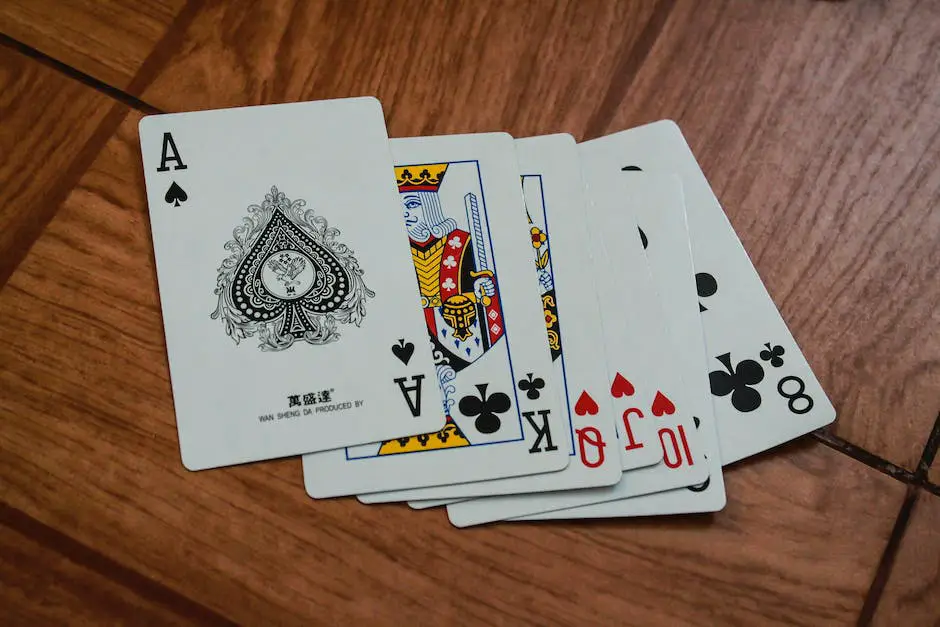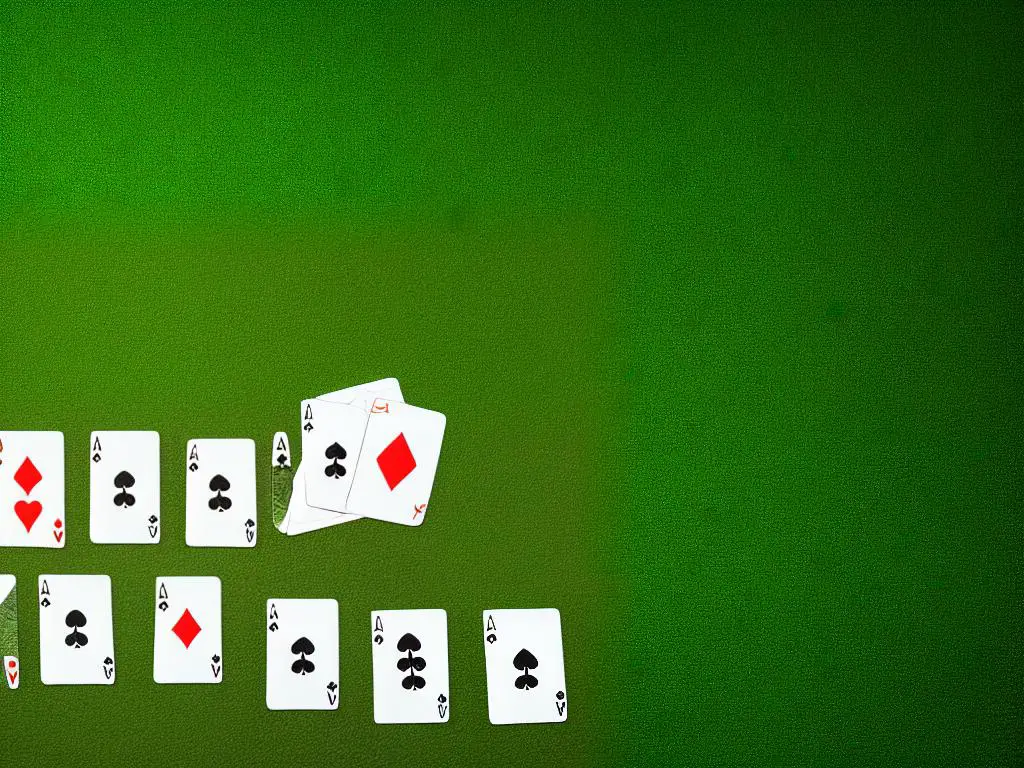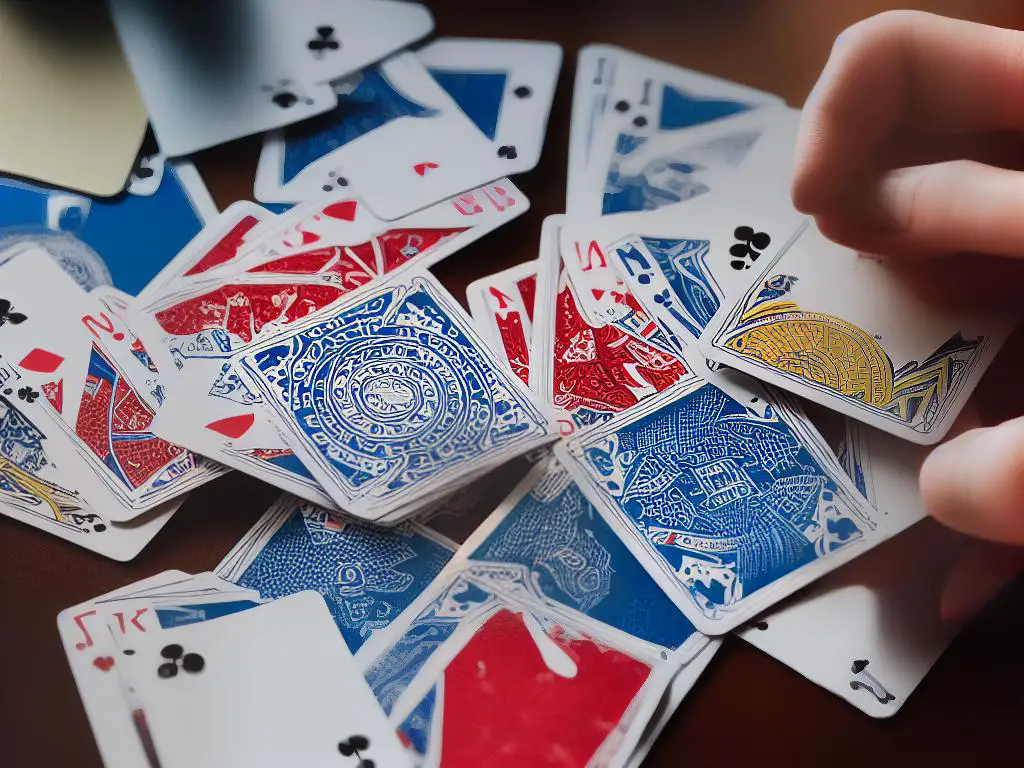Embark on an exciting journey to learn the ins and outs of the popular Golf card game. This fascinating game offers just the right blend of strategy and luck to make it compelling for players of all skill levels. From understanding the game basics, learning card rankings and values, setting up the game, to mastering the art of playing and scoring, this comprehensive guide has you covered. Get ready to elevate your game, discover various strategies, gameplay tips, and variations, and put your newfound skills to the test in practice sessions!
Understanding the game basics
Introduction:
The Golf card game is an entertaining and easy-to-learn game that can be played by individuals of all ages and skill levels. This guide will provide you with the essential information on understanding the basics of the Golf card game, including its objective, number of players, and equipment needed to start playing. Let’s dive in!
Objective:
The primary goal of the Golf card game is to score the lowest points possible, similar to golf’s traditional scoring system. Players aim to discard and replace cards from their hands to form pairs, sets, or sequences that would result in the lowest total score. The game typically consists of a pre-determined number of rounds, and the player with the lowest overall score at the end of all rounds is declared the winner.
Number of Players:
The Golf card game can be played with two, three, or four players. It is most commonly played with four players, but it can be easily adapted for a fewer number of players. When playing with more than four people, modifications may be required, such as using multiple decks of cards or adjusting the scoring system.
Equipment Needed:
- One standard deck of 52 playing cards: The Golf card game requires players to use a standard deck of playing cards with no jokers. If playing with more than four people, consider using two decks of cards.
- A scorekeeping method: This may include pen and paper to record each player’s scores after every round or a digital scorekeeping app on your smartphone.
- A flat surface to play on: This can be a table or any other flat surface where all players can easily access their cards and see the playing area.
Conclusion:
Now that you understand the basics of the Golf card game, you can begin learning the gameplay and strategies involved in mastering the game. With practice and experience, you’ll soon become a confident player and enjoy the challenge that Golf card game provides. So, gather your friends, grab a deck of cards, and start playing this engaging and entertaining game!
Learning the card rankings and values
Gathering the Deck
Begin by collecting a standard 52-card deck (excluding Jokers). These playing cards consist of four suits: Hearts, Diamonds, Clubs, and Spades. Each suit contains 13 cards, ranking from Ace to King.
Understanding the Suits
Familiarize yourself with the four suits in the deck. Hearts and Diamonds are colored red, while Clubs and Spades are colored black. In the Golf card game, the suits do not affect the card values and are not used in determining rankings.
Learning the Rankings
The cards within each suit are ranked as follows (from lowest to highest): Ace, 2, 3, 4, 5, 6, 7, 8, 9, 10, Jack, Queen, and King. In Golf, Aces are always considered low and have the lowest value among all cards.
Determining Card Values
In the Golf card game, each card represents a certain point value based on its ranking. Here are the point values associated with the cards:
- Ace (A): 1 point
- Number cards (2-10): face value in points (e.g., a 2 is worth 2 points, a 6 is worth 6 points, etc.)
- Jack (J): 10 points
- Queen (Q): 10 points
- King (K): 0 points
Special Cases for Card Values
There are two additional rules in certain variations of Golf that you should be aware of:
- In some versions, the 10 cards are assigned a point value of -5 (minus five) instead of 10.
- If both of a player’s hole cards (the face-down cards) at the end of a round are Queens, their value changes from 10 points each to -5 (minus five) points each, making the total value of the two Queens -10 (minus ten) points.
Practicing Familiarity with Rankings and Values
Spend some time going through the deck to get accustomed to identifying each card’s ranking and point value quickly. Being able to accurately and quickly determine the values and rankings of cards in the Golf card game will help you make better decisions while playing and improve your chances of winning.
Game Objective
Finally, keep in mind that the goal of the Golf card game is to have the lowest score possible at the end of a predetermined number of rounds (usually, 9 rounds to represent the 9 holes in Golf). Each card in your final hand will be tallied to calculate your score for that round. The player with the lowest aggregated score after all rounds is the winner.
Setting up the game
Gathering Materials
To play the Golf card game, you’ll need a standard deck of 52 playing cards, a piece of paper and a pen or pencil to keep score. You may also want a flat surface, such as a table, to play on.
Determining the Number of Players
Golf can be played with 2-4 players. Once you’ve determined the number of players, everyone should find a comfortable seat around the playing surface.
Choosing a Dealer
Randomly select a player to be the dealer. To do this, you can shuffle the cards and have each player draw a card – the player with the highest-ranking card becomes the dealer. Alternatively, you can simply agree on a dealer.
Shuffling the Deck
The dealer should thoroughly shuffle the playing cards to ensure a fair game. This may involve shuffling the cards several times to make sure they are well mixed.
Dealing the Cards
The dealer deals six cards to each player, face-down. In a two-player game, lay out two additional rows of three cards face-down between the players. In a 3-4 player game, lay out one additional row of three cards face-down in the center of the table.
Arranging Your Cards into a Grid
Every player should arrange their cards into two rows of three cards each, without looking at the individual card values.
Turning a Card Face Up
Each player chooses one of their cards to turn face-up, revealing its value to everyone else. This will help guide strategy and decision-making as the game progresses.
Creating the Discard Pile and Draw Pile
The dealer places the remaining deck of cards face-down in the center of the playing area to create the draw pile. Then, the dealer flips the top card of the draw pile face-up and places it next to the draw pile to start the discard pile. Make sure there is enough space around the draw and discard piles for players to access them during the game.
Establishing Turn Order
The player to the left of the dealer goes first, with play continuing clockwise around the table.
Reviewing the Scoring System
Before beginning the game, make sure all players understand the scoring system for Golf. Each number card is worth its face value, face cards (kings, queens, and jacks) are worth 10 points, and aces are worth 1 point. The objective is to have the lowest score at the end of nine rounds, just like in golf.
Beginning the Game
Now that everything is set up, the first player can start their turn and the game of Golf is underway!

Playing and scoring
Materials Needed:
- At least two players (more are welcome)
- A standard 52-card deck (remove Jokers)
- Paper and pen for keeping score
Objective:
The objective of the Golf card game is to have the lowest score at the end of a predetermined number of rounds (usually 9 or 18, like in traditional golf).
Setting Up the Game:
- Determine the number of rounds you want to play (9 or 18).
- Shuffle the deck, and deal six cards to each player, face down.
- Each player organizes their cards face-down in a 3×2 grid in front of them, without looking at the cards.
- From the remaining deck, turn the top card face-up to start the discard pile.
- Keep the remaining face-down cards in a deck next to the discard pile, forming the draw pile.
Gameplay:
- Each player, starting with the one to the left of the dealer and continuing clockwise, takes a turn by either drawing a card from the draw pile or picking up the top card from the discard pile. The player then replaces one card in their grid with the drawn card, by swapping them. The discarded card is placed face-up in the discard pile.
- Players are allowed to peek at the cards in their grid before drawing a card, but they must not let other players see their cards, and they cannot swap cards within their grid.
- The first two turns of the game must involve flipping two cards from the grid (one per turn). The players must replace these cards with cards drawn from the draw pile.
- After everyone has taken two turns to flip their cards, players can begin choosing between drawing from the draw pile or picking up the top card from the discard pile as described earlier.
- Players have only one opportunity during the game to peek at a card in their grid without having to replace it.
- The round continues until one player successfully replaces all six of their face-down cards with face-up cards, or no cards remain in the draw pile.
Scoring:
- Once a round ends, all players turn their grids face-up and calculate their scores according to the following card values:
- Ace: 1 point
- Numbers 2 to 10: face value
- Jack and Queen: 10 points
- King: 0 points
- Two cards of the same rank (number/letter) in the same row or column cancel each other out and score zero points.
- Add each player’s scores and record them on the score sheet.
- If you’re playing multiple rounds, continue playing until all rounds are completed.
- At the end of the final round, the player with the lowest total score wins.
Conclusion:
Now that you’re familiar with the rules and gameplay of the Golf card game, get some friends together and enjoy a friendly competition. Remember, practice makes perfect – so the more you play, the better you’ll become at strategizing and scoring in this fun and engaging game.

Strategies and gameplay tips
Introduction:
Golf is a fun and competitive card game that can be played with 2 to 4 players. The objective of the game is to score the lowest number of points over the course of 9 or 18 rounds, just like in real golf. Players achieve low scores by replacing their dealt cards with lower value cards from the draw pile or discard pile. Although Golf is a game of luck, some strategies and gameplay tips can help you gain an edge and increase your chances of winning.
1. Familiarize yourself with the rules:
The best way to excel at any card game is to have a firm understanding of the rules. There are several variations of golf, so ensure you are well-versed with the specific rules that you and your fellow players decide to use. Common rule variations include using 4, 6, or 9 cards in each player’s grid and whether picture cards are worth 10 points or face value.
2. Plan your moves:
Scan the cards you have on your grid and identify which cards are worth the most points. If you know what you want to accomplish, it will be easier to make quick decisions when it’s your turn to play. You can either aim to replace high-value cards or try to form columns with matching cards to score zero points.
3. Don’t focus solely on your own cards:
Keep an eye on what your opponents are doing during gameplay. If you notice someone consistently discarding low-value cards, be wary of their moves, as they might be close to finishing with a low score. Likewise, if someone keeps drawing from the discard pile, try to avoid discarding useful cards for them.
4. Use the discard pile wisely:
If you have the opportunity to play a card from the discard pile, weigh your options carefully. Taking a decent card from the discard pile denies your opponent the chance to use that card. However, you should also keep in mind that if you exclusively pick cards from the discard pile, you may limit your chances of drawing valuable cards from the draw pile.
5. Remember pairs and triplets:
In most Golf variations, having an entire column with matching cards results in zero points. Try to form pairs or triplets as they lower your overall score and give you a better chance of winning.
6. Avoid hoarding high-value cards:
If you’re holding onto a high-value card with the hope of pairing or tripling it later, consider whether it’s worth the risk. Higher-value cards will increase your score, while low-value ones can be replaced without significant consequences.
7. Don’t let your opponents know your strategy:
Your facial expressions and mannerisms can indicate your gameplay strategy to experienced opponents. Try to maintain a poker face and avoid providing any clues to other players about your strategy.
Conclusion:
The Golf card game is an enjoyable game where skill and strategy can make all the difference. By incorporating these gameplay tips and strategies, you can improve your chances of winning and have more fun playing with friends and family. Remember, practice makes perfect, so keep playing Golf to sharpen your skills and become an expert!

Variations of the Golf card game
Golf Variants
Golf is a popular card game that is fun and engaging for all ages. It is often played with two to four players, although it can accommodate larger groups as well.
Each version of Golf has slightly different rules, which influence the gameplay.
Four-Card Golf
Playing Four-Card Golf involves the following steps:
- Setup: Each player receives four face-down cards arranged in a 2×2 grid. Players do not look at their cards. The remaining deck is placed in the center of the table, and the top card is turned over to begin the discard pile.
- Gameplay: Starting with the player to the left of the dealer, players take turns drawing a card from the deck or the discard pile. The goal is to replace one of their face-down cards with the drawn card to achieve the lowest score possible. Players can also choose to discard the drawn card immediately. Once a player has replaced a card, they must flip the replaced card face-up, and that card cannot be changed again. Players then discard a card, ending their turn.
- Scoring: After all four cards in a player’s grid are face-up, the round ends, and players calculate their scores. Cards two through ten are worth their face value, face cards are worth 10, and Aces are worth 1. The player with the lowest score wins the round.
Six-Card Golf
Six-Card Golf is played similarly to Four-Card Golf, but with a few differences:
- Setup: Each player is dealt six face-down cards arranged in a 3×2 grid.
- Gameplay: Players follow the same rules as Four-Card Golf, aiming to flip all their cards face-up to reveal the lowest score possible.
- Scoring: After all six cards are face-up, the round ends, and scores are calculated. In this variation, the lowest and highest card in each column is scored, while the middle card does not count toward the total. The player with the lowest score wins the round.
Optional Rules
- Negative Scoring: In both variations, you can use negative values for certain card combinations, such as having a pair of matching cards in the same column. This can lead to more strategic gameplay.
- Wild Cards: Designate a card as a wild card (usually Jokers) that allows players to replace any card in their grid.
- Knocking: Allow players to “knock” instead of drawing a card if they believe they have the lowest score. The other players then get one more turn before the round ends.
Three-Player Variant
This variant is played similarly to Four-Card Golf but with some additional rules to adapt it for three players:
- Setup: Deal four face-down cards to each player arranged in a 2×2 grid.
- Gameplay: In each round, the first player draws two cards and chooses one for themselves and one to pass to the left. The second player then chooses to either keep or discard the passed card before drawing from the deck or discard pile. The third player follows the same procedure as the second player.
- Scoring: The round ends when all players have their cards face-up. Calculate scores as in the original versions.
Conclusion
By exploring these different variants of Golf, you can enjoy unique gameplay elements and find the version that suits you best. Happy playing!

Practice sessions
Playing the Golf Card Game: Practice Sessions
In order to truly understand and master the Golf card game, it’s important to participate in multiple practice sessions. Here, we’ll outline the steps for practicing the game to help you increase your skill level and enjoyment of playing.
Step 1: Gather the Necessary Materials
To play Golf, you’ll need a standard deck of 52 playing cards. You can also use a pad of paper and a pen or pencil to keep track of the score throughout the game.
Step 2: Understand the Objective and Basic Rules
Before you start practicing, make sure you’re familiar with the objective of Golf and the basic rules. The goal in Golf is to end the game with the lowest score possible. Each card represents a certain number of points, and you’ll gain points for the cards in your tableau (the cards on the table in front of you) by the end of the game. Your main job is to try to replace higher-scoring cards with lower-scoring ones.
Step 3: Set Up the Game
To set up a practice session for Golf, shuffle the deck and deal six cards face-down to each player. Then, arrange these cards in a 2×3 layout in front of each player. Make sure not to peek at the cards. The remaining cards are placed in the center, forming the draw pile. Flip the top card from the draw pile face-up, creating the discard pile.
Step 4: Begin the Round
Decide who goes first, then begin the round. Each turn, a player can either draw a card from the draw pile or the discard pile. If they choose a card from the draw pile, they can either use it to replace one of their existing cards in the tableau, or they can discard it immediately if it’s not helpful. If a player picks a card from the discard pile, they must use it to replace one of the cards in their tableau.
Step 5: Flip and Swap the Cards
Practice flipping and swapping cards strategically, as this is where most of the skill in Golf comes into play. Remember that you want to end up with the lowest point total, so always keep an eye on the point values of your cards as you play.
Step 6: End the Round
A round of Golf ends when one player has all of their tableau cards face-up. Everyone gets one final turn before the round is over. Tally up the scores for each player, then start a new round.
Step 7: Multiple Rounds and Recording Scores
Golf is typically played in a series of nine rounds (hence the name, which is inspired by the sport of golf). As you practice, be sure to record your scores for each round on your notepad. This will help you track your progress and develop better strategies.
Step 8: Reflect on Your Strategy
After each practice session, reflect on your strategy – what worked well, and what didn’t. Consider whether you need to change your approach to certain cards, as well as how you can more effectively use the discard pile to your advantage.
Step 9: Play with Different Players
To truly improve your skills at Golf, it’s important to play with different people. Each player will likely have their own strategies and methods for playing, which can help you learn new techniques and perspectives.
Step 10: Repeat and Enjoy
The key to mastering Golf is practice. Keep playing multiple sessions, refining your strategies, and enjoying the game. With time and experience, you’ll become a skilled player and have fun along the way!
Now that you’ve familiarized yourself with the Golf card game’s intricacies, you’re well equipped to impress your friends and family at your next game night. As you continue to grow in confidence and skill, you’ll find that this intriguing game always has something new to offer. So grab a deck of cards and embrace the opportunity to immerse yourself in the captivating world of Golf card game and create unforgettable memories around the table.
